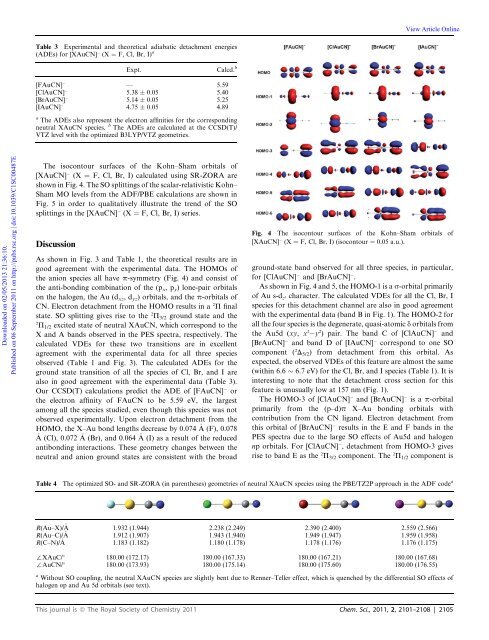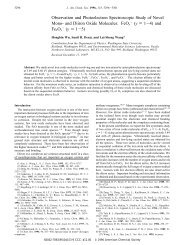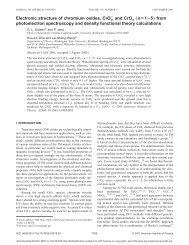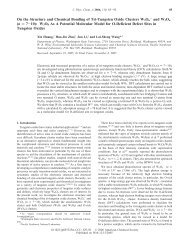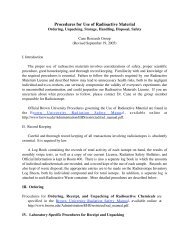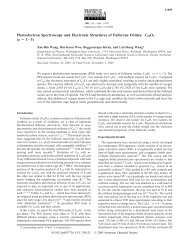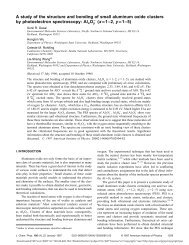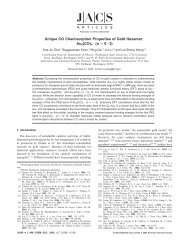Chemical Science EDGE ARTICLE - Chemistry Department at ...
Chemical Science EDGE ARTICLE - Chemistry Department at ...
Chemical Science EDGE ARTICLE - Chemistry Department at ...
You also want an ePaper? Increase the reach of your titles
YUMPU automatically turns print PDFs into web optimized ePapers that Google loves.
View Article OnlineTable 3 Experimental and theoretical adiab<strong>at</strong>ic detachment energies(ADEs) for [XAuCN] (X ¼ F, Cl, Br, I) aExpt.Calcd. b[FAuCN] — 5.59[ClAuCN] 5.38 0.05 5.40[BrAuCN] 5.14 0.05 5.25[IAuCN] 4.75 0.05 4.89a The ADEs also represent the electron affinities for the correspondingneutral XAuCN species. b The ADEs are calcul<strong>at</strong>ed <strong>at</strong> the CCSD(T)/VTZ level with the optimized B3LYP/VTZ geometries.Downloaded on 02/05/2013 21:36:10.Published on 06 September 2011 on http://pubs.rsc.org | doi:10.1039/C1SC00487EThe isocontour surfaces of the Kohn–Sham orbitals of[XAuCN] (X ¼ F, Cl, Br, I) calcul<strong>at</strong>ed using SR-ZORA areshown in Fig. 4. The SO splittings of the scalar-rel<strong>at</strong>ivistic Kohn–Sham MO levels from the ADF/PBE calcul<strong>at</strong>ions are shown inFig. 5 in order to qualit<strong>at</strong>ively illustr<strong>at</strong>e the trend of the SOsplittings in the [XAuCN] (X ¼ F, Cl, Br, I) series.DiscussionAs shown in Fig. 3 and Table 1, the theoretical results are ingood agreement with the experimental d<strong>at</strong>a. The HOMOs ofthe anion species all have p-symmetry (Fig. 4) and consist ofthe anti-bonding combin<strong>at</strong>ion of the (p x ,p y ) lone-pair orbitalson the halogen, the Au (d xz ,d yz ) orbitals, and the p-orbitals ofCN. Electron detachment from the HOMO results in a 2 P finalst<strong>at</strong>e. SO splitting gives rise to the 2 P 3/2 ground st<strong>at</strong>e and the2P 1/2 excited st<strong>at</strong>e of neutral XAuCN, which correspond to theX and A bands observed in the PES spectra, respectively. Thecalcul<strong>at</strong>ed VDEs for these two transitions are in excellentagreement with the experimental d<strong>at</strong>a for all three speciesobserved (Table 1 and Fig. 3). The calcul<strong>at</strong>ed ADEs for theground st<strong>at</strong>e transition of all the species of Cl, Br, and I arealso in good agreement with the experimental d<strong>at</strong>a (Table 3).Our CCSD(T) calcul<strong>at</strong>ions predict the ADE of [FAuCN] orthe electron affinity of FAuCN to be 5.59 eV, the largestamong all the species studied, even though this species was notobserved experimentally. Upon electron detachment from theHOMO, the X–Au bond lengths decrease by 0.074 A (F), 0.078A (Cl), 0.072 A (Br), and 0.064 A (I) as a result of the reducedantibonding interactions. These geometry changes between theneutral and anion ground st<strong>at</strong>es are consistent with the broadFig. 4 The isocontour surfaces of the Kohn–Sham orbitals of[XAuCN] (X ¼ F, Cl, Br, I) (isocontour ¼ 0.05 a.u.).ground-st<strong>at</strong>e band observed for all three species, in particular,for [ClAuCN] and [BrAuCN] .As shown in Fig. 4 and 5, the HOMO-1 is a s-orbital primarilyof Au s-d z2 character. The calcul<strong>at</strong>ed VDEs for all the Cl, Br, Ispecies for this detachment channel are also in good agreementwith the experimental d<strong>at</strong>a (band B in Fig. 1). The HOMO-2 forall the four species is the degener<strong>at</strong>e, quasi-<strong>at</strong>omic d orbitals fromthe Au5d (xy, x 2 y 2 ) pair. The band C of [ClAuCN] and[BrAuCN] and band D of [IAuCN] correspond to one SOcomponent ( 2 D 5/2 ) from detachment from this orbital. Asexpected, the observed VDEs of this fe<strong>at</strong>ure are almost the same(within 6.6 6.7 eV) for the Cl, Br, and I species (Table 1). It isinteresting to note th<strong>at</strong> the detachment cross section for thisfe<strong>at</strong>ure is unusually low <strong>at</strong> 157 nm (Fig. 1).The HOMO-3 of [ClAuCN] and [BrAuCN] is a p-orbitalprimarily from the (p–d)p X–Au bonding orbitals withcontribution from the CN ligand. Electron detachment fromthis orbital of [BrAuCN] results in the E and F bands in thePES spectra due to the large SO effects of Au5d and halogennp orbitals. For [ClAuCN] , detachment from HOMO-3 givesrise to band E as the 2 P 3/2 component. The 2 P 1/2 component isTable 4The optimized SO- and SR-ZORA (in parentheses) geometries of neutral XAuCN species using the PBE/TZ2P approach in the ADF code aR(Au–X)/ A 1.932 (1.944) 2.238 (2.249) 2.390 (2.400) 2.559 (2.566)R(Au–C)/ A 1.912 (1.907) 1.943 (1.940) 1.949 (1.947) 1.959 (1.958)R(C–N)/ A 1.183 (1.182) 1.180 (1.178) 1.178 (1.176) 1.176 (1.175):XAuC/ 180.00 (172.17) 180.00 (167.33) 180.00 (167.21) 180.00 (167.68):AuCN/ 180.00 (173.93) 180.00 (175.14) 180.00 (175.60) 180.00 (176.55)a Without SO coupling, the neutral XAuCN species are slightly bent due to Renner–Teller effect, which is quenched by the differential SO effects ofhalogen np and Au 5d orbitals (see text).This journal is ª The Royal Society of <strong>Chemistry</strong> 2011 Chem. Sci., 2011, 2, 2101–2108 | 2105


